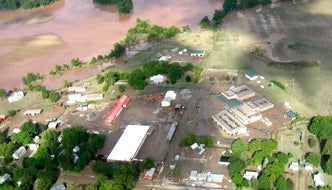 In late summer 2011, Hurricane Irene and Tropical Storm Lee left extensive damage in the Capital Region, especially along creeks and riverbeds. In the aftermath, several communities, including the Village of Schoharie, worked to pick up the pieces, while dealing with the impact of extreme flooding, rainfall, and power outages. The impact was very personal for Lillian Spina-Caza, lecturer in the Department of Communication and Media, who is a Schoharie resident.
In late summer 2011, Hurricane Irene and Tropical Storm Lee left extensive damage in the Capital Region, especially along creeks and riverbeds. In the aftermath, several communities, including the Village of Schoharie, worked to pick up the pieces, while dealing with the impact of extreme flooding, rainfall, and power outages. The impact was very personal for Lillian Spina-Caza, lecturer in the Department of Communication and Media, who is a Schoharie resident.
Today, with assistance from a $90,000 grant from the New York State Council on the Arts, Spina-Caza and Schoharie Area Long Term Inc. (SALT) are working to develop the “Geo to Go” interactive website and augmented reality (AR) arts, cultural, and heritage trails project.
“The research problems that I am concerned with are how new communication technology—including social media and augmented reality apps—can be used to speed recovery in post-disaster events and, later, to revitalize the culture and economy of communities devastated by such tremendous events,” said Spina-Caza. “The SALT ‘Geo to Go’ website and AR trails project are inspired by this research.”
In 2013, Spina-Caza coordinated with SALT, the New York Folklore Society, and members of RPI Relief on a story collection project to record oral narratives from flood survivors and recovery volunteers. RPI Relief is a program of the Dean of Students Office at Rensselaer that is focused on raising awareness and funds, as well as coordinating volunteer initiatives, when disasters strike an area. In addition to the story collection project, Spina-Caza, SALT staff, and VISTA volunteers collected survey data about volunteerism in the aftermath of flooding. The stories and data they gathered are part of a larger-scale research and design project that Spina-Caza is working on.
 Currently, Spina-Caza is supervising producer for the multimedia content that will be used for the SALT “Geo-To-Go” interactive website and mobile AR app. The first of several interactive trails planned for the website and app include the Schoharie County Quilt Barn Trail, the Schoharie County Beverage Trail, and the Schoharie County Farm Trail.
Currently, Spina-Caza is supervising producer for the multimedia content that will be used for the SALT “Geo-To-Go” interactive website and mobile AR app. The first of several interactive trails planned for the website and app include the Schoharie County Quilt Barn Trail, the Schoharie County Beverage Trail, and the Schoharie County Farm Trail.
From May to July, Spina-Caza traveled the county with a production team from Working Pictures Inc., collecting videotape footage of the trails. To date, she has produced more than 40 videotape interviews for the premiere trails, and is in the process of editing the footage. These interviews will be accessible on the interactive website and also on trails throughout the county via geographic information system (GIS) technology and the mobile app. As tourists and residents travel the physical trails, they will also learn more about arts, culture, and historical treasures in Schoharie County on their mobile devices.
The ability to use AR to overlay virtual information or images on the physical world will allow travelers to see, for example, how a community appeared pre-flood, and to help communities reclaim their heritage by preserving memories of things lost.
“The field of communication and media has been changed forever by new communication technology and there are many opportunities for research that can examine the roles these technologies might have in assisting people suffering in the aftermath of human or natural disasters on both a national and global scale,” Spina-Caza said. “This project creates an opportunity to envision and shape how new media can change the way we can positively respond to such events to speed recovery and, further, to use technology for community revitalization post-disaster or crisis.”
“Professor Spina-Caza’s application of augmented reality to cultural and natural history is a truly unique way to preserve the societal impact of this natural disaster,” said Dean Mary Simoni. “Her collaboration with state and community agencies establishes a strategic inter-institutional alliance aimed at not only preserving our past and making it available to a wider audience, but as a way to advance disaster preparedness.”
“The research and design projects I am currently working on reflect Rensselaer’s strategy to ‘spur regional and national economic development’ through technology innovation,” Spina-Caza added. “The project that I am working on with SALT supports resilience, hope, and constructive change to revitalize communities still recovering physically and economically from natural disasters. We hope the website and AR app will be a model for this type of research and development, and that other communities will be able to recreate it and use it for similar purposes.”


